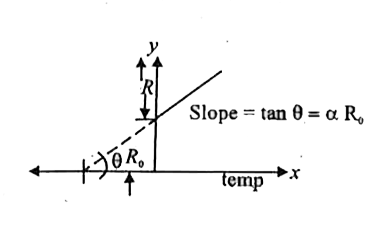Write a note on the variation of resistance of a metallic conductor with temperature.Solution in Kannada
The resistance of a conductor increases or decreases with the increase or decrease of temperature.
R=R0(1+αt+βt2+γt3+…) where α,β,γ are called the I order, II order and III order temperature coefficients respectively. However, β,γ, ............ are far less than .α..
Hence R=R0(1+αt), to a near degree of approximation. Electrical resistance varies linearly with the resistance due to collision between electrons and oscillating ions in the lattice.
We can show that α=R−R0R0tK−1. Temperature coefficient resistance of a conductor is defined as the ratio of change in the resistance per degree kelvin change in the temperature to its resistance at 0∘C or 273 K.
A graph of resistance along the y-axis and temperature along the x-axis, gives a straight line with ay-intercept .R0. and slope of the line .R0α..
α=(1R0) ) (slope of the line).

The x-intercept on the .-x. axis indicates that the resistance of the conductor vanishes at a temperature called transition or critical temperature. Conductors become super conductors at the critical temperature and below it. The phenomenon of conductors losing all the resistance to the flow of charges at the critical temperature and below it is known as super conductivity.
Topper's Solved these Questions
- CURRENT ELECTRICITYBOOK - SUBHASH PUBLICATIONCHAPTER - CURRENT ELECTRICITYEXERCISE - NUMERICAL PROBLEMS AND ANSWERS
29 Videos
- CURRENT ELECTRICITYBOOK - SUBHASH PUBLICATIONCHAPTER - CURRENT ELECTRICITYEXERCISE - THREE MARK QUESTIONS AND ANSWERS
11 Videos
- COMMUNICATION SYSTEMS BOOK - SUBHASH PUBLICATIONCHAPTER - COMMUNICATION SYSTEMS EXERCISE - THREE MARKS QUESTIONS WITH ANSWERS
4 Videos
- DUAL NATURE OF RADIATION AND MATTERBOOK - SUBHASH PUBLICATIONCHAPTER - DUAL NATURE OF RADIATION AND MATTEREXERCISE - NUMERICALS WITH SOLUTIONS
21 Videos
Similar Questions
In the given circuit, calculate the effective resistance between A and B.

View SolutionA uniform wire of resistance 9Ω is bent to form an equilateral triangle. What is the effective resistance between any two corners of the triangle.
View SolutionOutline the production of an Amplitude Modulated Wave.
View SolutionA photo has a wavelength of 5000 Å. Calculate its momentum.
View SolutionThe variation of resistance of a metallic conductor with temperature is shown in figure. (i) Calculate the temperature coefficient of resistance from the graph. (ii) State why the resistance of the conductor increases with the rise in temperature.
View SolutionThe resistance of a metallic conductor increases with temperature due to.
View SolutionWhen the temperature of a metallic conductor is increased, its resistance
View SolutionWrite a note on the variation of metallic nature in a group and in a period.
View SolutionVariation of resistance of the conductor with temperature is shown . Temperature coefficient of the conductor is
View SolutionWrite an expression for the resistivity of a metallic conductor showing its variation over a limited range of temperatures.
View SolutionWrite a note on variation of metallic nature in groups and periods
View SolutionWith the increase of temperature, the ratio of conductivity to resistivity of a metal conductor
View SolutionThe resistance of a metallic conductor increases with temperature, because
View SolutionIn all metallic conductors, electric conduction is due to drifting of free electrons. But the resistivity of different metals are different. Explain the variation of resistivity with temperature.
View SolutionWrite a note on the variation of metallic nature in a group and in a period.
View Solution